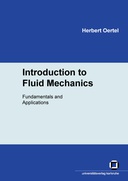Explore

Introduction to fluid mechanics. Originalveröffentl. im Verl. Vieweg, Braunschweig, 2001
Herbert Oertel
2005
0 Ungluers have
Faved this Work
Login to Fave
This textbook on fluid mechanics is aimed at engineering students at Bachelor's degree level. In Chapter 2 the fundamentals of fluid mechanics, needed for the description and analysis of flows in technology, are presented. One-dimensional stream filament theory, along with the momentum integral and angular momentum integral equations, already present us with one method of constructing fluid technological appliances and experiments. For example, the dimensions of a machine can be determined quite accurately in one first step and predictions made about the flow losses which occur.However, these methods fail when machines are to be optimized, or when appliances are to be developed to operate under extreme conditions, such as silent operation, high efficiency, small dimensions, greatly damped oscillatory behavior, etc. In addition to this, even for most simple cases of application, simple fluid mechanical fundamentals cannot determine the operating behavior of a machine accurately enough. This requires extensive experiments to be carried out and these can be very costly and time consuming.At this point we refer to more detailed textbooks which progress systematically from the fundamental fluid mechanical equations and their methods of solution to the application of fluid mechanical software.The methods used in fluid mechanics are analytical, numerical and experimental. Although numerical methods are increasingly used to replace experimental methods, all three are still needed to solve fluid mechanical problems. This book is restricted to theoretical, that is analytical, methods. After working through this book, students are qualified to understand the basics and phenomena of fluid mechanics, and will have obtained an initial insight into fluid mechanical software, even if further studies into the fundamental equations of fluid mechanics and numerical methods are necessary for the application of this software.The composition of this book is partly very theoretical. In order not to lose sight of the connection to technical applications during the extensive derivations, we have selected flows past airplane wings, flows past vehicles and flows in pipes of process engineering systems as representative examples to illustrate the basics of one-dimensional fluid mechanics.We now introduce the student to the great variety of fluid mechanical applications, demonstrating that flows are all around us in our technological environment, by describing selected examples of flows in the following introductory sections.
This book is included in DOAB.
Why read this book? Have your say.
You must be logged in to comment.
